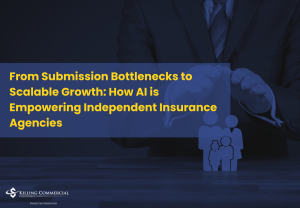Maximizing Middle-Market Workers’ Compensation Success: Data-Driven Prospecting, Compliance Wedges, and Claims Excellence

Middle-market businesses face unique challenges when it comes to managing their workers’ compensation programs. Unlike large enterprises, they often lack dedicated in-house resources for safety, compliance, and claims oversight; yet unlike small businesses, their scale subjects them to more sophisticated regulatory scrutiny and larger potential losses. In this environment, commercial insurance producers who master an integrated approach—combining precise prospecting data, impactful compliance applications, and exceptional claims handling—can both win new accounts and build lasting client relationships.
In this comprehensive guide, we explore how to leverage high-quality data to identify the best prospects, deploy year-round compliance “wedges” to deepen engagement, transform the claims process into a value driver, and use advanced tactics—like audit support and underinsurance analysis—to create an unbeatable competitive edge. Whether you’re building a new workers’ comp practice or looking to differentiate your current book of business, these strategies will help you drive revenue, reduce risk, and become your clients’ go-to advisor.
This general session featured insights from Rob Gifford, Dustin Boss, Randy Boss, Jesse Dantice, Kevin Ring.
Leveraging Accurate Data for Targeted Prospecting
Importance of High-Quality Data
Effective prospecting data goes beyond basic demographic information. The most successful producers access comprehensive, state-by-state databases that include renewal dates, NAICS and FIC codes, payroll ranges, and Lost Cost Multipliers. By filtering on these criteria, you can pinpoint accounts that are both large enough to move the needle and approaching a renewal window—when clients are most open to conversation.
For example, sorting by NAICS code allows you to hone in on specific industries, such as manufacturing or hospitality, where your expertise can shine. Filtering for Lost Cost Multiplier anomalies (accounts whose LCM deviates significantly from the industry norm) often uncovers underpriced or poorly managed risks—prime targets for producers who can offer more robust solutions.
Identifying High-Potential Prospects
Once your data filters are in place, rank prospects by:
- Renewal Imminence: Clients with renewals within 90 days should top your outreach list.
- Carrier Appetite: Focus on risks your target carriers are actively seeking—leveraging market intelligence to avoid chasing uninsurable accounts.
- Audit History: Accounts with frequent audit adjustments often indicate unstable payroll reporting or underinsurance, both of which you can address.
By combining these factors, you create a prospecting list optimized for high conversion rates. Use a lead-management tool like Insurance XD or your agency’s CRM to tag and schedule follow-up tasks, ensuring no hot lead falls through the cracks.
Tools & Platforms
Several technology platforms excel at delivering the data and workflows producers need:
- Insurance XD: Offers robust state-level filtering, real-time renewal alerts, and integration with carrier appetite guides.
- NAICS Lookup Tools: Free online lookup services help you verify industry codes and standardize your database.
- LCM Benchmarking Reports: Available through industry associations, these reports highlight outliers in loss cost multipliers.
Select the tools that integrate seamlessly with your existing CRM and agency management system, minimizing manual data entry and maximizing efficiency.
Creating Compliance-Based Engagement Wedges
OSHA Logs & Automated Safety Reminders
Meeting only at renewal leaves significant revenue and relationship-building opportunities on the table. Instead, introduce compliance applications—such as OSHA log management and automated safety-training reminders—to spark “wedge” conversations throughout the policy term.
For instance, deploying a quarterly OSHA Log review reminds clients of your ongoing value. Pair that review with short, interactive safety quizzes delivered via email or mobile app. These bite-sized touchpoints cost you almost nothing but demonstrate your proactive commitment to reducing workplace injuries.
Building Year-Round Conversations
Continuous engagement keeps you top of mind and positions you as a trusted advisor rather than a transactional rate-quote vendor. Examples include:
- Monthly Safety Bulletins: Curate industry-specific tips to reduce leading causes of injuries.
- Mid-Term Compliance Check-Ins: Schedule virtual or on-site meetings to review training records and incident trends.
- Regulatory Updates: Send concise summaries of new state regulations or OSHA guidelines relevant to their operations.
By embedding these compliance wedges into your service model, you create meaningful touchpoints that reinforce your value proposition well before renewal season arrives.
Turning Claims into a Differentiator
Streamlined Claims Workflows
In middle-market accounts, claims can make or break your client relationships. Producers who view claims handling as an extension of their service offering can differentiate themselves significantly. Partner with platforms that integrate carrier reporting portals, automate notifications, and trigger best-practice workflows—such as return-to-work planning and light-duty coordination.
Providing a branded client portal where policyholders can report incidents directly to you and the carrier simplifies the process. Automated workflows then guide your team through each step: claim acknowledgment, documentation collection, medical appointment scheduling, and subrogation investigation.
Measurable Outcomes
To solidify your role as a strategic advisor, track and report on key performance indicators:
- Lost-Time Days Saved: Compare actual lost-time days against industry benchmarks.
- Average Claim Duration: Show reductions in claim lifecycle lengths after your interventions.
- Return-to-Work Rates: Highlight the percentage of injured workers returning to duty within targeted timeframes.
Present these metrics in quarterly or annual reviews, using data visualization to underscore the bottom-line impact of your claims management services.
Understanding Prospecting Triggers & Emotional Pain Points

Stress as a Prospecting Trigger
Sales conversations rooted in genuine client pain capture attention. The most overlooked trigger? Stress—the anxiety clients feel around last-minute renewals, audit surprises, or escalating loss trends.
Begin your outreach with questions like:
“When does your current workers’ comp policy renew, and do you feel prepared for the audit adjustments that often follow?”
Such openers tap into clients’ fear of the unknown and position you as the solution to their immediate stress.
Experience Modification as an Objective Baseline
The experience modification factor (mod) provides an objective conversation starter. Highlighting a client’s mod—especially if it’s trending upward—can quickly transition into discussions on loss prevention programs, training initiatives, and targeted safety investments.
Example: “I noticed your mod increased from 0.90 to 1.10 this year. Let’s explore how tailored safety protocols can bring that number back under 1.00 and reduce your total cost of risk.”
Emotional Drivers
Beyond data, people buy solutions that address their emotions: security, control, and peace of mind. Frame your conversations to emphasize:
- Avoiding Future Pain: “I can help you avoid the audit headaches that caught you off guard last year.”
- Gaining Control: “Our safety-audit process gives you clear steps to manage compliance proactively.”
- Protecting Reputation: “Demonstrating strong safety metrics improves your market positioning and employee morale.”
By combining rational data with emotional framing, you create compelling reasons for prospects to engage.
Power of Process Improvement & Automation
Automated Safety Training & Reporting
Scaling your safety-service offerings often requires automation. Implement a safety-training platform that:
- Delivers micro-learning modules on high-risk topics (e.g., fall prevention, forklift safety).
- Tracks completion rates and quiz scores for regulatory compliance.
- Sends automatic reminders to employees who fall behind.
This approach not only elevates workplace safety but also provides you with rich engagement data—another talking point during renewal discussions.
Outsourcing vs. Internal Scaling
Deciding whether to build internal compliance capabilities or partner with third-party vendors depends on your agency’s size and growth strategy. Key considerations:
- Volume of Accounts: High volume favors automation and outsourcing.
- Control & Branding: An in-house solution may deliver a more personalized client experience.
- Cost & Expertise: Outsourcing can offer specialized expertise at lower incremental cost.
Whichever path you choose, ensure your clients receive consistent, professional service that aligns with your brand promise.
Delivering on Promises & Retention Strategies
Closing the Loop
One of the simplest ways to build trust is by following through on every promise. Whether it’s delivering a quarterly safety report or setting up a claims review meeting, always confirm completion.
At mid-term, send a brief “Here’s what we’ve done so far” summary, highlighting completed actions and upcoming steps. This “closing the loop” cements your reputation for reliability.
Mid-Term Check-Ins
Don’t wait until 30 days before renewal to reach out. Schedule mid-term compliance reviews—virtual or on-site visits halfway through the policy term. These reviews can cover:
- OSHA log analysis
- Claim trends year-to-date
- Status of recommended safety improvements
By keeping the engagement calendar full, you reduce renewal leakage and increase retention rates.
Advanced Tactics: Audit Support & Underinsurance Opportunities

Prospecting Gold in Audits
Audits often reveal subcontractor relationships, payroll misclassifications, and underinsurance issues. Instead of viewing audit triggers as client headaches, see them as prospecting gold.
Offer a complimentary audit-preparation session, and then use the subcontractor certificate roster to build your next prospect list. This proactive approach demonstrates real value and replenishes your pipeline.
Addressing Underinsured Limits
Underinsurance—gaps between actual policy limits and needed coverage—is a chronic issue in middle-market accounts. Position umbrella liability and excess workers’ comp as logical extensions of their primary policy:
“By layering an umbrella policy at $5 million, you shield your balance sheet from catastrophic losses that exceed your primary limits.”
Framing these coverages as risk-management essentials rather than upsells helps clients see their necessity.
Building a Sustainable Workers’ Comp Practice
Niche Specialization & Revenue Metrics
Choosing a niche—such as construction, manufacturing, or healthcare—allows you to develop deeper expertise and market credibility. Track performance metrics like:
- New account win rate by niche
- Average policy premium per niche
- Growth in cross-sell ratios
Use these metrics to refine your focus and allocate resources where they yield the highest returns.
Certification & Continuous Improvement
Invest in your professional credentials to enhance client confidence. Earning the Certified Workers’ Comp Advisor (CWCA) designation or completing advanced safety-management courses demonstrates your commitment to excellence. Share these certifications on your website and in client communications to underscore your expertise.
Conclusion & Next Steps
Winning and retaining middle-market workers’ compensation accounts demands more than competitive pricing—it requires a holistic service model built on data-driven prospecting, year-round compliance engagement, and superior claims management. To recap:
- Leverage robust data—filter by renewal date, industry code, and LCM anomalies to prioritize prospects.
- Deploy compliance wedges—use OSHA logs and safety reminders to create ongoing touchpoints.
- Transform claims—integrate streamlined workflows and track key outcomes to reinforce value.
- Trigger emotional buy-in—address stress points and use the experience mod as a conversation starter.
- Automate wisely—scale safety training and reporting without sacrificing quality.
- Close the loop—follow through on commitments and conduct mid-term reviews to boost retention.
- Exploit audits—turn audit findings into new opportunities and address underinsurance proactively.
- Specialize & certify—focus on niche segments and invest in professional credentials for credibility.
Action Checklist:
- Schedule a data-cleanup session to ensure your CRM filters are accurate.
- Launch a quarterly OSHA Log email campaign next month.
- Partner with a claims-management platform to automate first-notice-of-loss workflows.
- Offer audit-preparation workshops to select clients and prospects.
- Enroll in a CWCA program by Q4 to bolster your credentials.
By implementing these strategies, you’ll not only win new middle-market workers’ comp accounts but also build the kind of trusted relationships that drive renewal and referral business year after year. For more resources on enhancing your workers’ compensation strategy, visit our resource library or schedule a personalized consultation today.

How AI and Automation Are Reshaping Independent Insurance Agencies
In an industry where tradition often outweighs innovation, artificial intelligence and automation are slowly but steadily reshaping how independent insurance agencies operate. The push toward smarter, more efficient workflows is no longer a matter of if—but when. While many agencies are still evaluating how AI fits into their operations, early adopters are already reaping the benefits of streamlined submissions, faster processing, and actionable data insights.

Coaching, Competition, and Consolidation: Inside the Protege Mindset That’s Reshaping the Future of Insurance Producers
The commercial insurance industry is changing faster than ever—and not always for the better. Consolidation is accelerating. Service levels are declining. Private equity is pushing agencies to scale in ways that strip out the personal touch that once defined the independent channel. But for the producers willing to do the work, lean into mentorship, and sharpen their craft, this isn’t a challenge—it’s an opportunity.

From Submission Bottlenecks to Scalable Growth: How AI is Empowering Independent Insurance Agencies
The commercial insurance industry is in the midst of a major evolution. The traditional workflows that once drove agency productivity are now dragging down growth, overloading staff, and frustrating owners who are trying to scale efficiently. For independent insurance agencies—especially those in the middle market—adapting to these challenges without increasing overhead is a tightrope walk.

The Power of Patient Prospecting: How Education, Niching, and Mindset Drive Middle-Market Success
Few industries reward consistency, discipline, and patience quite like middle-market commercial insurance. Initially, every producer starts with a different story, background, and path into the business. However, the ones who rise are the ones who learn to embrace the long game. Moreover, while success may take time, those who persevere ultimately reap the benefits. Furthermore, this industry values resilience, and those who remain committed often find themselves achieving great success in the end.

Reclaiming Purpose in a Distracted World: Empowerment, Emotional Intelligence, and the Future of Work-Life Balance
In today’s performance-obsessed culture, achieving elite status in your profession can often come with a hidden price. Tania Khazaal, known to many as Tanya the Herbalist, knows this truth firsthand. After climbing the ranks in the insurance industry and landing in the top 1% of sales professionals, she found herself at a crossroads. Despite the accolades, international travel perks, and consistent recognition, she was suffering from a quiet crisis: burnout.

From Confusion to Clarity: How Insurance Agencies Can Unlock Growth Through Strategic Leadership and Culture
In the fast-paced world of commercial insurance, the grind of daily operations often blinds agency leaders to the foundational cracks forming beneath them. Producers are focused on closing deals. Account managers are buried in servicing. Agency principals are juggling leadership, sales, operations, and finance. Yet in the midst of this hustle, many agencies lack the one thing that can unlock the next level of growth: organizational clarity.

Responses